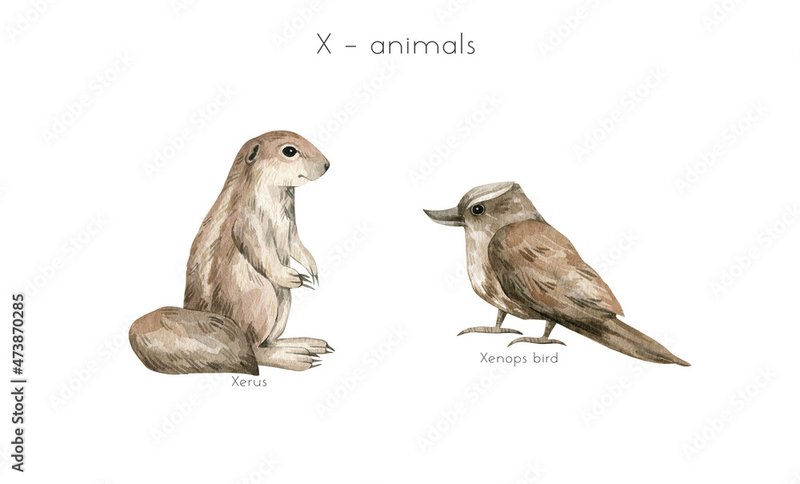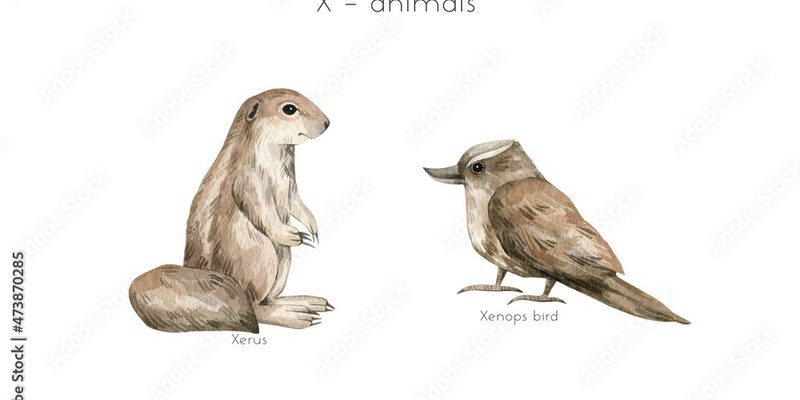
Have you ever seen a squirrel darting across your backyard, playfully chasing its friends? Now, imagine a bigger and more adventurous version of that squirrel, found in the vast savannas and arid regions of Africa. That’s the Xerus, a genus of ground squirrels that captures the hearts (and laughs) of those who witness their energetic antics. These lively creatures are not only entertaining but also serve important roles in their ecosystems.
Belonging to the family Sciuridae, the Xerus is particularly famous for its social behavior and adaptability. They form large colonies, often filled with amusing interactions and intriguing dynamics. Imagine a bustling community where each squirrel has its role, from foraging for food to keeping a lookout for predators. It’s a remarkable sight that highlights their unique way of life.
Physical Characteristics of the Xerus
Xeruses are medium-sized rodents, typically ranging from about 22 to 40 centimeters (8.7 to 15.7 inches) in length. Their bodies are slender and built for speed, featuring long legs and a bushy tail that aids in balance while they run or climb. The fur of a Xerus is usually a dusty brown or gray, providing excellent camouflage against the dry grass and soil of their habitat. This coloration is crucial for survival, as it helps them evade predators.
In addition to their color, Xeruses have distinctive physical features, such as large eyes that grant them excellent vision, particularly during the day. Their strong front paws are adept at digging and foraging for food, making them well-suited for life in the wild. You might also notice their long whiskers, which help them navigate their surroundings, especially in low light conditions.
Habitat and Range
Xeruses are primarily found across various parts of Africa, especially in countries like Namibia, Botswana, and South Africa. They thrive in dry, open areas such as savannas and scrublands, where they can easily dig their burrows and find food. The habitat not only provides shelter from the sun but also offers plenty of opportunities for foraging.
These ground squirrels build extensive burrow systems that can stretch over several meters and include multiple entrances. This architecture is crucial for their safety from predators like snakes, birds of prey, and larger mammals. Imagine living in a cozy underground apartment with secret escape routes—that’s a Xerus for you!
Diet and Feeding Behavior
The diet of a Xerus is primarily herbivorous, consisting of seeds, nuts, fruits, and green vegetation. They are particularly fond of seeds from grasses and other plants found in their habitats. However, they are opportunistic feeders and won’t hesitate to munch on insects when available. This diverse diet helps them adapt to changing environments and seasons.
Foraging is a communal activity for Xeruses. They are often seen scurrying around together, using teamwork to find the best food sources. When one squirrel spots food, it emits a series of chirps to alert the others. This is a fascinating example of their social behavior and communication skills. It’s a bit like a dinner bell ringing, calling everyone to join in for a feast.
Social Structure and Behavior
Xeruses are incredibly social animals, often living in colonies that can include dozens of individuals. They engage in social grooming, playing, and even cooperative care of the young. This social structure helps them establish strong bonds and improve their chances of survival. Imagine a bustling community where everyone looks out for each other—it’s heartwarming to see!
These squirrels have a complex communication system filled with various vocalizations and body language. From chirping and chattering to tail movements, each gesture conveys important information about their surroundings, such as the presence of predators. This level of communication is essential for survival, allowing them to respond quickly to threats.
Reproduction and Lifespan
The mating season for Xeruses typically occurs in the spring. Females are known to be quite selective, often choosing mates based on their strength and social standing within the colony. After a gestation period of about 30 days, a female usually gives birth to 2 to 6 pups. These little ones are born blind and helpless, relying heavily on their mothers for care during the early weeks of life.
Xerus pups grow rapidly, becoming more independent within a couple of months. By the time they are weaned, they start to explore their surroundings, learning essential skills from their parents and other colony members. With proper care, Xeruses can live up to 6 years in the wild, although their lifespan can extend in captivity due to fewer threats and better food sources.
Conservation Status
Currently, Xeruses are not considered endangered, but they do face various threats. Habitat loss due to agriculture and human encroachment poses significant challenges. Additionally, they can fall prey to domestic animals and hunting. Conservation efforts focus on preserving their habitats and ensuring that these playful rodents continue to thrive in the wild.
It’s important for us to understand the vital role that Xeruses play in their ecosystems. They help aerate the soil through their digging activities, which promotes plant growth. They also serve as a food source for larger predators, making them a crucial part of the food chain. Protecting Xeruses means looking out for the entire ecosystem.
Interesting Facts about Xerus
| Species: | Xerus inauris (Cape ground squirrel) |
| Size: | 22 – 40 cm (8.7 – 15.7 inches) |
| Weight: | 500 – 800 grams (1.1 – 1.8 lbs) |
| Diet: | Herbivorous: seeds, nuts, fruits, insects |
| Habitat: | Savannas and scrublands in Africa |
| Social Structure: | Colonial, often living in large groups |
| Lifespan: | Up to 6 years in the wild |
In summary, the Xerus is more than just a cute and playful rodent. These fascinating creatures play vital roles in their ecosystems, exhibit interesting social behaviors, and adapt remarkably to their environments. Whether you’re lucky enough to spot a Xerus in the wild or read about them in this article, understanding their world gives us insight into the beauty of nature and the importance of conservation. So, next time you see a squirrel, think of its lively African cousins—the Xerus.
FAQ
What is the primary habitat of the Xerus?
The Xerus primarily inhabits dry, open areas like savannas and scrublands across Africa. They dig extensive burrows in these habitats, which not only offer shelter but also safety from predators. This unique nesting behavior is essential for their survival, helping them thrive in challenging environments.
How do Xeruses communicate with each other?
Xeruses have a complex system of communication that includes vocalizations such as chirps and chattering, along with body language and tail movements. These signals help alert other colony members to dangers and promote social bonding. Communication is a critical aspect of their survival strategy and social structure.
What do Xeruses eat?
Xeruses are primarily herbivorous, feeding on seeds, nuts, fruits, and various green plants. They are opportunistic feeders and will consume insects when available. Their varied diet allows them to adapt to the seasonal changes in their environment, ensuring that they can find food year-round.
How do Xeruses protect themselves from predators?
Xeruses rely on their excellent camouflage, social behavior, and underground burrows to protect themselves from predators. They have strong community ties, with individuals taking turns to watch for threats while others forage for food. This teamwork enhances their chances of survival in the wild.
What is the breeding process for Xeruses like?
During mating season, female Xeruses choose their mates based on strength and social status. After a gestation period of about 30 days, they give birth to 2 to 6 pups. The pups are initially dependent on their mothers, requiring care and protection as they grow and learn essential survival skills.
What threats do Xeruses face today?
While Xeruses are not currently endangered, they face threats such as habitat loss due to agriculture and urban development. Additionally, they can be hunted by domestic animals and face challenges from predators. Conservation efforts aim to protect their natural habitats and ensure their continued survival in the wild.
How long do Xeruses live in the wild?
Xeruses can live up to 6 years in the wild, although their lifespan can be longer in captivity. Factors such as food availability, predation, and disease can impact their life expectancy in natural habitats. Understanding their lifespan helps in forming conservation strategies to protect these playful creatures.
Are Xeruses social animals?
Yes, Xeruses are highly social creatures, often living in colonies where they engage in grooming, playing, and cooperative care of the young. This social structure is vital for their survival, as it enhances their ability to warn each other of dangers and find food more efficiently.
Can Xeruses be kept as pets?
While Xeruses are fascinating animals, they are not suitable as pets for most people. They have specific dietary and environmental needs, and their social nature requires interaction with others of their kind. Observing them in their natural habitat is the best way to appreciate their unique behaviors.
How do Xeruses contribute to their ecosystem?
Xeruses play significant roles in their ecosystems by aerating the soil through their burrowing activities, which promotes plant growth. They also serve as a food source for larger predators, thereby maintaining the balance within their food chain. Protecting these animals helps ensure a healthy ecosystem overall.
What are some fun facts about Xeruses?
Xeruses are known for their playful behavior and agility. They can run at impressive speeds, often leaping and making quick changes in direction to evade predators. Their lively antics and social interactions make them a delight to observe in the wild, showcasing the joy and complexity of nature.

